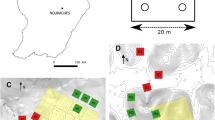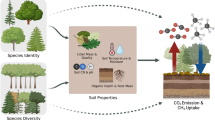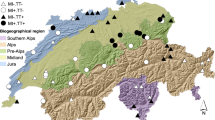Abstract
Forest soils are an important component of CO2 and CH4 fluxes at the global scale, but the magnitude of these fluxes varies greatly in space and time within a landscape. Understanding the spatial and temporal distributions of these fluxes across complex landscapes remains a major challenge for researchers and land managers alike. We investigated the spatiotemporal variability of soil-atmosphere CO2 and CH4 fluxes and the relationships of these fluxes to chemical and physical soil properties distributed across a topographically-heterogeneous landscape. Soil CO2 and CH4 fluxes were measured along with soil temperature, moisture, bulk density, texture, carbon, sorption capacity, and dissolved organic matter quality over 2 years along hillslope transects spanning valley bottom, transition zone, and upland landscape positions in a temperate forest watershed. Transition zone soil CO2 efflux was 54–160% higher than low-lying valley bottoms, and 15–54% higher than uplands. Net seasonal CH4 uptake was 58–150% higher in transition zone soils than in uplands, while valley bottoms were occasionally large net sources (up to 19 nmol CH4 m−2 s−1). Soil CO2 efflux and net CH4 uptake were both positively associated with seasonal temperature, and were highest in soils with relatively high carbon and clay content, and relatively low bulk density, moisture, and sorption capacity. We concluded that: (1) transition zone soils act as landscape hotspots for net CH4 uptake in addition to CO2 efflux, and (2) that this spatial distribution is more consistent across seasons for net CH4 uptake than for CO2 efflux.




Similar content being viewed by others
References
Ambus P, Christensen S (1995) Spatial and seasonal nitrous oxide and methane fluxes in danish forest-, grassland-, and agroecosystems. J Environ Qual 24:993
Anderson RH, Matthews ED (1973) Soil survey of Cecil County, Maryland. United States Department of Agriculture Soil Conservation Service, Washington, D.C.
Atkins JW, Epstein HE, Welsch DL (2014) Vegetation heterogeneity and landscape position exert strong controls on soil CO2 efflux in a moist, Appalachian watershed. Biogeosciences 11:17631–17673. https://doi.org/10.5194/bgd-11-17631-2014
Ball BC (2013) Soil structure and greenhouse gas emissions: a synthesis of 20 years of experimentation. Eur J Soil Sci. https://doi.org/10.1111/ejss.12013
Ball BC, Dobbie KE, Parker JP, Smith KA (1997) The influence of gas transport and porosity on methane oxidation in soils. J Geophys Res 102:23301. https://doi.org/10.1029/97JD00870
Boeckx P, Van Cleemput O, Villaralvo I (1997) Methane oxidation in soils with different textures and land use. Nutr Cycl Agroecosyst 49:91–95. https://doi.org/10.1023/A:1009706324386
Bouyoucos GJ (1962) Hydrometer method improved for making particle size analyses of soils. Agron J 54:464–465. https://doi.org/10.2134/agronj1962.00021962005400050028x
Brumme R, Borken W (1999) Site variation in methane oxidation as affected by atmospheric deposition and type of temperate forest ecosystem. Soil Sci 13:493–501
Ceddia MB, Vieira SR, Villela ALO et al (2009) Topography and spatial variability of soil physical properties. Sci Agric 66:338–352. https://doi.org/10.1590/S0103-90162009000300009
Creed IF, Webster KL, Braun GL et al (2013) Topographically regulated traps of dissolved organic carbon create hotspots of soil carbon dioxide efflux in forests. Biogeochemistry. https://doi.org/10.1007/s10533-012-9713-4
Crill PM (1991) Seasonal patterns of methane uptake and carbon dioxide release by a temperate woodland soil. Glob Biogeochem Cycles 5:319–334. https://doi.org/10.1029/91GB02466
Davidson EA, Belk E, Boone RD (1998) Soil water content and temperature as independent or confounded factors controlling soil respiration in a temperate mixed hardwood forest. Glob Chang Biol. https://doi.org/10.1046/j.1365-2486.1998.00128.x
Del Grosso SJ, Parton WJ, Mosier AR et al (2000) General CH4 oxidation model and comparisons of CH4 oxidation in natural and managed systems. Glob Biogeochem Cycles 14:999–1019
Delaware Environmental Observing System (DEOS) (2017) University of Delaware, Newark DE. www.deos.udel.edu. Accessed 31 Jan 2017
Dixon R, Solomon A, Brown S et al (1994) Carbon pools and flux of global forest ecosystems. Science 263:185–190. https://doi.org/10.1126/science.263.5144.185
Fellman JB, Hood E, D’Amore DV et al (2009) Seasonal changes in the chemical quality and biodegradability of dissolved organic matter exported from soils to streams in coastal temperate rainforest watersheds. Biogeochemistry. https://doi.org/10.1007/s10533-009-9336-6
Fellman JB, Hood E, Spencer RGM (2010) Fluorescence spectroscopy opens new windows into dissolved organic matter dynamics in freshwater ecosystems: a review. Limnol Oceanogr 55:2452–2462. https://doi.org/10.4319/lo.2010.55.6.2452
Gomez J, Vidon P, Gross J et al (2017) Spatial and temporal patterns of CO2, CH4, and N2O Fluxes at the soil-atmosphere interface in a northern temperate forested watershed. Sci Pages For Res 1:1–12
Gough CM, Vogel CS, Kazanski C et al (2007) Coarse woody debris and the carbon balance of a north temperate forest. For Ecol Manag. https://doi.org/10.1016/j.foreco.2007.03.039
Guckland A, Flessa H, Prenzel J (2009) Controls of temporal and spatial variability of methane uptake in soils of a temperate deciduous forest with different abundance of European beech (Fagus sylvatica L.). Soil Biol Biochem 41:1659–1667. https://doi.org/10.1016/j.soilbio.2009.05.006
Hanson PJ, Edwards NT, Garten CT, Andrews JA (2000) Separating root and soil microbial contributions to soil respiration: a review of methods and observations. Biogeochemistry. https://doi.org/10.1023/A:1006244819642
Harmon ME, Bond-Lamberty B, Tang J, Vargas R (2011) Heterotrophic respiration in disturbed forests: a review with examples from North America. J Geophys Res Biogeosci 116:1–17. https://doi.org/10.1029/2010JG001495
Hibbard KA, Law BE, Reichstein M, Sulzman J (2005) An analysis of soil respiration across Northern hemisphere temperate ecosystems. Source Biogeochem Soil Respir 73:29–70
Hishi T, Hirobe M, Tateno R, Takeda H (2004) Spatial and temporal patterns of water-extractable organic carbon (WEOC) of surface mineral soil in a cool temperate forest ecosystem. Soil Biol Biochem. https://doi.org/10.1016/j.soilbio.2004.04.030
Huguet A, Vacher L, Relexans S et al (2009) Properties of fluorescent dissolved organic matter in the Gironde Estuary. Org Geochem 40:706–719. https://doi.org/10.1016/j.orggeochem.2009.03.002
Inamdar S, Dhillon G, Singh S et al (2013) Temporal variation in end-member chemistry and its influence on runoff mixing patterns in a forested, Piedmont catchment. Water Resour Res. https://doi.org/10.1002/wrcr.20158
Inamdar S, Johnson E, Rowland R et al (2017) Freeze–thaw processes and intense rainfall: the one-two punch for high sediment and nutrient loads from mid-Atlantic watersheds. Biogeochemistry. https://doi.org/10.1007/s10533-017-0417-7
Itoh M, Ohte N, Koba K et al (2007) Hydrologic effects on methane dynamics in riparian wetlands in a temperate forest catchment. J Geophys Res Biogeosci. https://doi.org/10.1029/2006JG000240
Kalbitz K, Schmerwitz J, Schwesig D, Matzner E (2003) Biodegradation of soil-derived dissolved organic matter as related to its properties. Geoderma 113:273–291. https://doi.org/10.1016/S0016-7061(02)00365-8
King AW, Andres RJ, Davis KJ et al (2015) North America’s net terrestrial CO2 exchange with the atmosphere 1990–2009. Biogeosciences. https://doi.org/10.5194/bg-12-399-2015
Kirschbaum MUF (2013) Seasonal variations in the availability of labile substrate confound the temperature dependence of organic matter decomposition. Soil Biol Biochem. https://doi.org/10.1016/j.soilbio.2012.10.012
Kleber M (2010) What is recalcitrant soil organic matter? Environ Chem. https://doi.org/10.1071/EN10006
Kleber M, Sollins P, Sutton R (2007) A conceptual model of organo-mineral interactions in soils: self-assembly of organic molecular fragments into zonal structures on mineral surfaces. Biogeochemistry 85:9–24. https://doi.org/10.1007/s10533-007-9103-5
Klüpfel L, Piepenbrock A, Kappler A, Sander M (2014) Humic substances as fully regenerable electron acceptors in recurrently anoxic environments. Nat Geosci 7:195–200. https://doi.org/10.1038/NGEO2084
Le Mer J, Roger P (2001) Production, oxidation, emission and consumption of methane by soils: a review. Eur J Soil Biol. https://doi.org/10.1016/S1164-5563(01)01067-6
Lecki NA, Creed IF (2016) Forest soil CO2 efflux models improved by incorporating topographic controls on carbon content and sorption capacity of soils. Biogeochemistry 129:307–323. https://doi.org/10.1007/s10533-016-0233-5
Leon E, Vargas R, Bullock S et al (2014) Hot spots, hot moments, and spatio-temporal controls on soil CO2 efflux in a water-limited ecosystem. Soil Biol Biochem. https://doi.org/10.1016/j.soilbio.2014.05.029
Lloyd J, Taylor JA (1994) On the temperature dependence of soil respiration. Source Funct Ecol Funct Ecol 8:315–323
McKeague JA, Day JH (1966) Dithionite- and oxalate-extractable Fe and Al as aids in differentiating various classes of soils. Can J Soil Sci 46:13–22. https://doi.org/10.4141/cjss66-003
Miller KE, Lai C-T, Friedman ES et al (2015) Methane suppression by iron and humic acids in soils of the Arctic Coastal Plain. Soil Biol Biochem 83:176–183. https://doi.org/10.1016/j.soilbio.2015.01.022
Mosier AR, Parton WJ, Valentine DW, Schimel DS (1996) CH4 and N2O fluxes in the Colorado shortgrass steppe: 1. Impact of landscape and nitrogen addition oxide. Global Biogeochem Cycles 10:387–399
Murphy KR, Stedmon CA, Graeber D, Bro R (2013) Fluorescence spectroscopy and multi-way techniques. PARAFAC. Anal Methods 5:6557. https://doi.org/10.1039/c3ay41160e
National Resources Conservation Service (2018) United States Department of Agriculture. Web Soil Survay. websoilsurvey.sc.egov.usda.gov. Accessed 29 Jan 2018
Ohno T (2002) Fluorescence inner-filtering correction for determining the humification index of dissolved organic matter. Environ Sci Technol 36:742–746. https://doi.org/10.1021/es0155276
Pacific VJ, McGlynn BL, Riveros-Iregui DA et al (2008) Variability in soil respiration across riparian-hillslope transitions. Biogeochemistry. https://doi.org/10.1007/s10533-008-9258-8
Pan Y, Birdsey RA, Fang J et al (2011) A large and persistent carbon sink in the world’s forests. Science. https://doi.org/10.1126/science.1201609
Pearson AJ, Pizzuto JE, Vargas R (2016) Influence of run of river dams on floodplain sediments and carbon dynamics. Geoderma. https://doi.org/10.1016/j.geoderma.2016.02.029
Pregitzer KS, Euskirchen ES (2004) Carbon cycling and storage in world forests: biome patterns related to forest age. Glob Chang Biol 10:2052–2077. https://doi.org/10.1111/j.1365-2486.2004.00866.x
Raich JW, Potter CS (1995) Global patterns of carbon dioxide emissions from soils. Glob Biogeochem Cycles 9:23–36
R Core Team (2017) R: a language and environment for statistical computing. R Foundation for Statistical Computing, Vienna. www.R-project.org
Saari A, Martikainen PJ, Ferm A et al (1997) Methane oxidation in soil profiles of dutch and finnish coniferous forests with different soil texture and atmospheric nitrogen deposition. Soil Biol Biochem 29:1625–1632
Schjønning P, Thomsen IK, Møberg JP et al (1999) Turnover of organic matter in differently textured soils I. Physical characteristics of structurally disturbed and intact soils. Geoderma 89:177–198. https://doi.org/10.1016/S0016-7061(98)00083-4
Schmidt MWI, Torn MS, Abiven S et al (2011) Persistence of soil organic matter as an ecosystem property. Nature. https://doi.org/10.1038/nature10386
Semenov MV, Kravchenko IK, Semenov VM et al (2010) Carbon dioxide, methane, and nitrous oxide fluxes in soil catena across the right bank of the Oka River (Moscow oblast). Eurasian Soil Sci. https://doi.org/10.1134/S1064229310050078
Shi B, Gao W, Cai H, Jin G (2016) Spatial variation of soil respiration is linked to the forest structure and soil parameters in an old-growth mixed broadleaved-Korean pine forest in northeastern China. Plant Soil. https://doi.org/10.1007/s11104-015-2730-z
Smith KA, Dobbie KE, Ball BC et al (2000) Oxidation of atmospheric methane in Northern European soils, comparison with other ecosystems, and uncertainties in the global terrestrial sink. Glob Chang Biol. https://doi.org/10.1046/j.1365-2486.2000.00356.x
Tonitto C, Gurwick NP, Woodbury PB, et al (2016) Quantifying greenhouse gas emissions from agricultural and forest landscapes for policy development and verification. In: Advances in Agricultural Systems Modeling. pp 229–304
Ueyama M, Takeuchi R, Takahashi Y et al (2015) Methane uptake in a temperate forest soil using continuous closed-chamber measurements. Agric For Meteorol. https://doi.org/10.1016/j.agrformet.2015.05.004
Vargas R, Allen M (2008) Environmental controls and the influence of vegetation type, fine roots and rhizomorphs on diel and seasonal variation in soil respiration. New Phytol 179:460–471. https://doi.org/10.1111/j.1469-8137.2008.02481
Wang JM, Murphy JG, Geddes JA et al (2013) Methane fluxes measured by eddy covariance and static chamber techniques at a temperate forest in central Ontario, Canada. Biogeosciences. https://doi.org/10.5194/bg-10-4371-2013
Warner DL, Villarreal S, McWilliams K et al (2017) Carbon dioxide and methane fluxes from tree stems, coarse woody debris, and soils in an upland temperate forest. Ecosystems 20(6):1205–1216. https://doi.org/10.1007/s10021-016-0106-8
Webster KL, Creed IF, Bourbonnière RA, Beall FD (2008) Controls on the heterogeneity of soil respiration in a tolerant hardwood forest. J Geophys Res Biogeosci. https://doi.org/10.1029/2008JG000706
Wei JB, Xiao DN, Zeng H, Fu YK (2008) Spatial variability of soil properties in relation to land use and topography in a typical small watershed of the black soil region, northeastern China. Environ Geol 53:1663–1672. https://doi.org/10.1007/s00254-007-0773-z
Weishaar J, Aiken G, Bergamaschi B et al (2003) Evaluation of specific ultra-violet absorbance as an indicator of the chemical content of dissolved organic carbon. Environ Sci Technol 37:4702–4708. https://doi.org/10.1021/es030360x
Yoo K, Amundson R, Heimsath AM, Dietrich WE (2006) Spatial patterns of soil organic carbon on hillslopes: integrating geomorphic processes and the biological C cycle. Geoderma. https://doi.org/10.1016/j.geoderma.2005.01.008
Yuan Z, Gazol A, Lin F et al (2013) Soil organic carbon in an old-growth temperate forest: spatial pattern, determinants and bias in its quantification. Geoderma. https://doi.org/10.1016/j.geoderma.2012.11.008
Yvon-Durocher G, Allen AP, Bastviken D et al (2014) Methane fluxes show consistent temperature dependence across microbial to ecosystem scales. Nature. https://doi.org/10.1038/nature13164
Acknowledgements
This research was funded by the United States Department of Agriculture (USDA-AFRI Grant 2013-02758), and we would like to acknowledge the University of Delaware Soil Testing Facility, Shawn Del Percio, Catherine Winters, and Samuel Villarreal for their help in the field and laboratory.
Author information
Authors and Affiliations
Corresponding authors
Additional information
Responsible Editor: James Sickman.
Electronic supplementary material
Below is the link to the electronic supplementary material.
Rights and permissions
About this article
Cite this article
Warner, D.L., Vargas, R., Seyfferth, A. et al. Transitional slopes act as hotspots of both soil CO2 emission and CH4 uptake in a temperate forest landscape. Biogeochemistry 138, 121–135 (2018). https://doi.org/10.1007/s10533-018-0435-0
Received:
Accepted:
Published:
Issue Date:
DOI: https://doi.org/10.1007/s10533-018-0435-0




